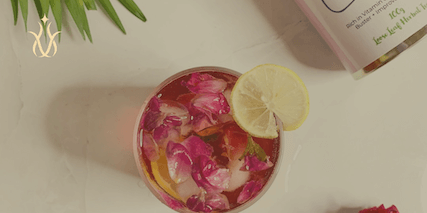Discover the top anti-aging superfoods to help you maintain youthful vitality and promote overall well-being. From antioxidant-rich berries to omega-3 fatty acid-packed fatty fish, this comprehensive guide unveils the best foods to include in your diet for healthy ageing. Enhance your skin, boost your energy, and support longevity with these nutrient-packed options. So start incorporating these anti-aging superfoods into your meals today and embrace a vibrant and youthful lifestyle.
Introduction to Anti-Aging Superfoods
Nutrition is a fundamental pillar when it comes to staying youthful and vibrant. Our food choices directly impact our body’s ability to repair, regenerate, and protect itself against the effects of aging. A well-balanced diet, packed with anti-aging foods, can significantly contribute to our overall health and well-being.
Consuming a diet rich in anti-aging foods offers a multitude of benefits. These foods are typically abundant in essential vitamins, minerals, antioxidants, and other bioactive compounds that support various bodily functions. They provide the necessary building blocks for our cells, tissues, and organs to function optimally, helping to slow down the aging process.
Not only do anti-aging foods nourish our bodies from the inside out, but they also play a crucial role in maintaining youthful skin, strong bones, sharp cognitive function, and a robust immune system. They can help reduce inflammation, combat oxidative stress, support cellular repair, and promote overall vitality.
By focusing on the best anti-aging foods, we can provide our bodies with the tools to protect against age-related diseases and maintain a higher quality of life as we age gracefully. These foods are often rich in antioxidants, which help neutralise harmful free radicals, preventing cellular damage and reducing the risk of chronic conditions such as heart disease, cancer, and neurodegenerative disorders.
Moreover, anti-aging foods are typically nutrient-dense, meaning they provide a high concentration of essential vitamins, minerals, and phytonutrients per calorie. This allows us to meet our nutritional needs while keeping our calorie intake in check, promoting healthy weight management and reducing the risk of obesity-related diseases.
In this article, we will explore an array of evidence-based anti-aging foods that have been scientifically proven to offer significant health benefits. From colourful fruits and vegetables to omega-3 fatty acid-rich fish and plant-based superfoods, we will delve into the properties and benefits of each food category. You’ll discover practical tips on incorporating these foods into your daily meals and optimise your nutrition for healthy aging.
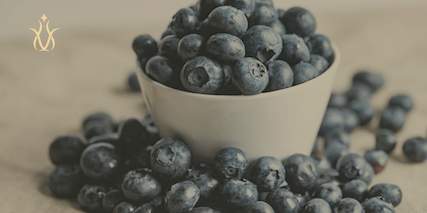
Blueberries: A Powerhouse of Antioxidants
Blueberries are an exceptional anti-aging food packed with an impressive array of antioxidants, particularly anthocyanin. These small, vibrant berries offer numerous health benefits and are a delicious addition to any diet.
Research has shown that anthocyanin, the pigment responsible for blueberries’ deep blue colour, possesses powerful antioxidant properties. These antioxidants help protect our cells from damage caused by harmful free radicals, which can accelerate aging and contribute to various chronic diseases.
Studies have indicated that the anthocyanin found in blueberries has the potential to reduce oxidative stress and fight inflammation, two key factors associated with aging and age-related diseases. These compounds have been shown to protect against cellular damage, improve cognitive function, support cardiovascular health, and promote a healthy immune system.
Blueberries are also packed full of Vitamin C, a powerful antioxidant that plays a significant role in anti-aging and maintaining youthful skin.
One of the key mechanisms through which vitamin C contributes to anti-aging is its role in collagen production. Collagen is a protein that provides structure and elasticity to the skin. As we age, collagen production naturally declines, leading to wrinkles, fine lines, and sagging skin. However, vitamin C stimulates collagen protein synthesis, helping to maintain skin firmness and reduce the visible signs of aging. In addition to its ability to preserve collagen, vitamin C is another potent antioxidant. Vitamin C helps protect the skin from oxidative stress and reduces the risk of cellular damage. This antioxidant activity also contributes to keep skin youthful appearance and preventing wrinkles.
Incorporating blueberries into your diet is simple and enjoyable. You can enjoy them as a snack on their own or add them to your favourite smoothies, cereals, yoghurt, or salads. Their natural sweetness and vibrant flavour make them versatile ingredients in a variety of dishes.
To fully reap the anti-aging properties of blueberries, consider keeping a stash of fresh or frozen blueberries on hand to easily incorporate them into your meals or snacks. For added convenience, you can also find blueberry extracts or powders that can be added to your favourite recipes or beverages.
Remember, when consuming blueberries, opt for organic and locally sourced varieties whenever possible to ensure the highest quality and maximum nutrient content. If fresh blueberries are not available, frozen blueberries are an excellent alternative, as they retain most of their nutritional value.

Fatty Fish: Omega-3 Fatty Acids for Healthy Skin
Including fatty fish such as salmon, mackerel, or sardines in your diet can provide numerous benefits for healthy aging, particularly when it comes to maintaining healthy skin. These fish are rich in omega-3 fatty acids, which offer a range of advantages for your skin and overall well-being.
Omega-3 fatty acids play a crucial role in promoting skin health by reducing inflammation and improving skin elasticity. Inflammation is a common underlying factor in various skin conditions and premature ageing. The anti-inflammatory properties of omega-3 fatty acids help calm inflammation within the body, which can lead to clearer, more younger looking skin.
Furthermore, these essential fatty acids support the production of collagen and elastin, proteins that provide structure and elasticity to the skin. By promoting collagen production, omega-3 fatty acids help maintain supple skin and reduce the appearance of fine lines and prevent wrinkles, contributing to a more youthful complexion.
When choosing fatty fish, opt for wild-caught varieties whenever possible. Wild-caught fish tend to have higher levels of inflammation-fighting fatty acids fatty content than their farm-raised counterparts. This is because wild-caught fish feed on a natural diet rich in marine plants and algae, which are abundant sources of omega-3s.
To incorporate fatty fish into your diet, consider various cooking methods such as grilling, baking, or steaming. These methods help retain the nutritional integrity of the fish while enhancing its natural flavours. Aim to include fatty fish in your meals at least two to three times a week to enjoy the full benefits of omega-3 fatty acids.
It is worth noting that individuals who are unable to consume fatty fish due to dietary restrictions or preferences can explore alternative sources of omega-3s, such as flaxseeds, chia seeds, walnuts, or algae-based supplements. However, consulting with a healthcare professional or registered dietitian is important to ensure you meet your nutritional needs.
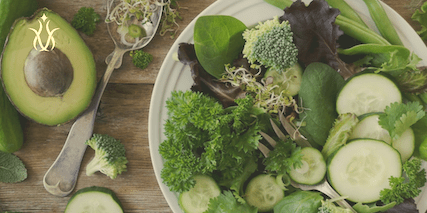
Leafy Greens: Nutrient Powerhouses for Youthful Vitality
Leafy green vegetables, such as spinach, kale, and Swiss chard, are vibrant and delicious additions to your meals and offer many anti-aging benefits. These nutrient powerhouses are packed with essential vitamins, antioxidants, and phytonutrients that can help protect against cellular damage and support overall vitality.
The importance of incorporating leafy greens into your diet cannot be overstated. These vegetables are rich in vitamins A, C, and E, which are powerful antioxidants that help fight free radical damage that can cause oxidative stress and damage our cells. Including leafy greens in your meals gives your body the necessary tools to combat cellular damage and support healthy aging.
In addition to vitamins, leafy greens are abundant in antioxidants and phytonutrients, which are plant compounds known for their health-promoting properties. These compounds help protect against chronic diseases, reduce inflammation, and support optimal cellular function. By including a variety of leafy greens in your diet, you can nourish your body with a wide range of beneficial phytonutrients.
Incorporating leafy greens into your meals doesn’t have to be a daunting task. Here are a few simple and delicious ways to include these nutrient powerhouses:
Salads:
Create a refreshing and nutrient-packed salad by combining different types of leafy greens, such as spinach, kale, and arugula. Add colourful vegetables, nuts, seeds, and a drizzle of extra-virgin olive oil for a healthy and satisfying meal.
Smoothies:
Blend a handful of leafy greens, such as spinach or kale, into your favourite smoothie recipe. The mild flavour of these greens pairs well with fruits and other ingredients, making it an easy way to boost your nutrient intake.
Stir-Fries:
Sauté leafy greens with other vegetables and lean proteins for a quick and nutritious stir-fry. Add garlic, ginger, and a splash of low-sodium soy sauce for flavour.
Wraps and Sandwiches:
Use large leafy greens, such as romaine lettuce or Swiss chard, as a healthy alternative to bread or tortillas in wraps or sandwiches. Fill them with your favourite lean proteins and vegetables for a nutrient-dense meal.
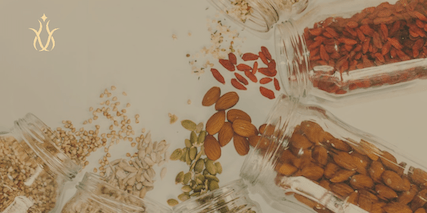
Nuts and Seeds: Promoting Longevity
Incorporating a variety of nuts and seeds, such as almonds, walnuts, flaxseeds, and chia seeds, into your diet can provide significant benefits for healthy aging. These small yet mighty powerhouses are packed with essential nutrients, including essential fatty acids, vitamins, minerals, and antioxidants that contribute to overall vitality and promote longevity.
Nuts and seeds are rich sources of essential fatty acids, particularly omega-3 fatty acids. These healthy fats play a crucial role in supporting brain health, reducing inflammation, and slowing down skin ageing. Omega-3 fatty acids, such as alpha-linolenic acid (ALA), eicosapentaenoic acid (EPA), and docosahexaenoic acid (DHA), have been associated with improved cognitive function and a reduced risk of chronic diseases.
Additionally, nuts and seeds are abundant in vitamins and minerals that are essential for healthy aging. For instance, vitamin E, found in almonds and sunflower seeds, is a potent antioxidant that helps protect against cellular damage caused by free radicals. Vitamin E has been linked to a decreased risk of age-related macular degeneration and cognitive decline.
Moreover, nuts and seeds contain a wide array of minerals, including magnesium, calcium, zinc, and selenium, which support bone health, immune function, and overall well-being. These minerals play crucial roles in maintaining healthy body functions and supporting the body’s natural defences against the effects of aging.
Incorporating nuts and seeds into your diet can be simple and enjoyable. Here are some suggestions for including them in your meals and snacks:
Salads:
Sprinkle a handful of chopped almonds or pumpkin seeds over your salads for added crunch and nutrition.
Yoghurt or Oatmeal Toppings:
Add a spoonful of flaxseeds, chia seeds, or crushed walnuts to your morning yoghurt or oatmeal for a nutrient boost.
Homemade Granola:
Make your own granola using a variety of nuts, seeds, and whole grains for a wholesome and satisfying snack.
Nut Butter:
Enjoy a spread of natural nut butter, such as almond or cashew butter, on whole-grain bread or as a dip for apple slices.
Colourful Vegetables: Vibrant Nutrients for Ageless Beauty
Including a variety of colourful vegetables like carrots, bell peppers, sweet potatoes, and tomatoes in your diet is essential for promoting ageless beauty and overall vitality. These vibrant vegetables are visually appealing and offer a wealth of vitamins, minerals, and antioxidants that contribute to healthy skin, vision, and overall well-being.
The importance of incorporating a rainbow of vegetables into your diet cannot be overstated. Each colourful vegetable brings a unique combination of nutrients that synergistically support various aspects of your health.
Colourful vegetables, such as carrots, are rich in a powerful antioxidant called beta-carotene, which the body converts into vitamin A. Vitamin A is essential for maintaining healthy skin, promoting cell turnover, and supporting a radiant complexion. Including carrots in your diet can help nourish your skin from within, reduce dryness, and improve skin tone.
Bell peppers, with their vibrant red, orange, and yellow hues, are packed with vitamin C, which is essential for collagen synthesis, and also acts as an antioxidant, protecting the skin from damage caused by harmful free radicals. Consuming bell peppers can help promote a youthful appearance, enhance skin elasticity, and reduce the signs of aging.
Tomatoes are known for their rich content of lycopene, another powerful antioxidant that gives them their bright red colour. Lycopene has been linked to numerous health benefits, including skin protection against sun damage, reducing the risk of certain cancers, and supporting cardiovascular health. Incorporating tomatoes into your diet, whether in fresh salads, cooked dishes or as a base for sauces, can contribute to your overall well-being.
To fully enjoy the benefits of colourful vegetables, including a variety of them in your meals is recommended. Here are some cooking and serving suggestions to help you incorporate a rainbow of vegetables into your diet:
Salads:
Create vibrant salads by combining different coloured vegetables, such as cherry tomatoes, bell peppers, carrots, and leafy greens. Add a sprinkle of herbs and a drizzle of extra-virgin olive oil for a refreshing and nutritious meal.
Roasting:
Roast a medley of colourful vegetables, including carrots, bell peppers, and zucchini, with a touch of olive oil and your favourite seasonings for a flavourful and nutritious side dish.
Stir-fries:
Prepare colourful stir-fries by sautéing an assortment of vegetables like bell peppers, broccoli, and snap peas with lean proteins for a quick and healthy meal.
Veggie Skewers:
Thread colourful vegetable chunks onto skewers and grill them for a delicious and visually appealing addition to your meals.
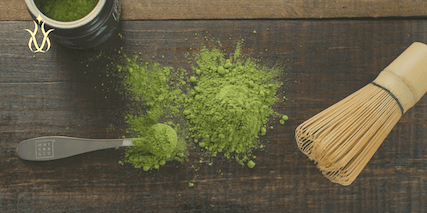
Green Tea: Elixir of Youth
Green tea and Matcha tea are renowned for their high concentration of antioxidants, particularly catechin, is often referred to as the elixir of youth. This ancient beverage offers numerous anti-aging benefits and is a valuable addition to any anti-aging diet.
The anti-aging properties of green tea can be attributed to its rich content of catechin, a type of antioxidant that helps protect against oxidative stress and supports healthy aging. Catechins have been shown to scavenge harmful free radicals in the body, reducing the risk of cellular damage and inflammation. By incorporating green tea into your daily routine, you can enhance your body’s defence against the effects of aging.
Studies have linked green tea consumption to a reduced risk of chronic diseases. The powerful antioxidants found in green tea may help lower the risk of heart disease, certain types of cancer, and neurodegenerative disorders. Additionally, green tea has been associated with improved brain function, increased fat oxidation, and weight management.
Preparing and enjoying green tea can be a delightful experience. Here are a few tips to maximise the benefits and enjoyment of this elixir of youth:
Opt for high-quality green tea or Matcha tea:
Choose loose-leaf green tea or high-quality tea bags to ensure you get the full spectrum of antioxidants and flavour.
Brewing temperature and time: Steep green tea in water that has been cooled to around 170-180°F (77-82°C) to avoid bitterness. Steeping for 2-3 minutes is generally recommended, but you can adjust the steeping time to achieve your desired strength.
Flavour additions:
Enhance green tea’s flavour and health benefits by adding a squeeze of lemon or a touch of honey. Lemon juice helps improve the absorption of catechin, while honey adds a hint of sweetness.
Enjoy it hot or cold:
Green tea can be enjoyed both hot and cold. Experiment with different temperatures and find the one that suits your preferences.
Incorporate green tea into recipes:
Besides enjoying green tea as a beverage, you can also incorporate it into various recipes. Use green tea as a base for smoothies, blend it into homemade ice cream or infuse it into salad dressings for a unique twist.
Whole Grains: Nourishment for Healthy Aging
Including whole grains like quinoa, brown rice, and oats in your diet is paramount for healthy aging. These nutrient-rich grains offer a range of benefits that contribute to overall well-being and support the aging process.
One key advantage of whole grains is their high fibre content. Fibre plays a crucial role in maintaining a healthy digestive system and promoting regular bowel movements. By including whole grains in your diet, you can support optimal digestion, prevent constipation, and maintain a healthy gut.
Whole grains also help maintain steady blood sugar levels. Whole grains’ fibre slows digestion, leading to a gradual release of glucose into the bloodstream. This helps prevent spikes and crashes in blood sugar levels, promoting stable energy levels and reducing the risk of chronic conditions such as type 2 diabetes.
In addition to their fibre content, whole grains are rich in vitamins, minerals, and antioxidants. These grains provide essential nutrients such as B vitamins, magnesium, iron, and selenium, which are vital for energy production, immune function, and overall health. Antioxidants found in whole grains help combat oxidative stress, reducing the risk of cellular damage and supporting healthy aging.
Incorporating whole grains into your meals can be both enjoyable and satisfying. Here are a few suggestions for incorporating these nourishing grains into your diet:
Salads:
Use cooked quinoa or brown rice as a base for hearty salads. Add a variety of colourful vegetables, lean proteins, and a flavourful dressing for a well-balanced meal.
Breakfast:
Start your day with a bowl of warm oatmeal topped with fresh berries, nuts, and a drizzle of honey. You can also incorporate whole grain cereals or toast into your breakfast routine for added fibre and nutrients.
Baking:
Replace refined grains with whole grain alternatives in your baked goods. Use whole wheat flour or oats in muffins, bread, or homemade granola bars for a healthier twist.
Side dishes:
Cooked whole grains like quinoa or brown rice are nutritious side dishes to accompany main meals. Add herbs, spices, and sautéed vegetables to enhance the flavour and nutritional value.
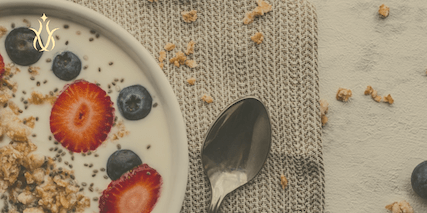
Yoghurt: Probiotics for Gut Health and Beyond
Consuming yoghurt, especially varieties containing live cultures and probiotics, offers a multitude of benefits for healthy aging. This creamy delight not only tantalises your taste buds but also provides various advantages for gut health and overall well-being.
The key benefit of yoghurt lies in its live cultures and probiotics. These beneficial bacteria support gut health by promoting a healthy balance of microorganisms in the digestive system. A thriving gut microbiota is essential for proper digestion, nutrient absorption, and a robust immune system.
Probiotics found in yoghurt help maintain the integrity of the gut lining, preventing the overgrowth of harmful bacteria and supporting optimal gut function. By promoting a healthy gut environment, probiotics can enhance nutrient absorption, reduce gastrointestinal discomfort, and support overall digestive health.
In addition to their impact on gut health, probiotics have also been linked to improved skin health and reduced signs of aging. Research suggests that the balance of gut bacteria plays a role in skin health and appearance. By supporting a healthy gut microbiota with probiotics, you may experience a clearer complexion, reduced inflammation, and improved skin elasticity.
When choosing yoghurt, look for options that contain active cultures or specifically mention the presence of probiotics. Opting for plain or unsweetened varieties allows you to control the sugar content and avoid unnecessary additives. Greek yoghurt, in particular, is known for its thick and creamy texture, making it a satisfying choice.
Here are some suggestions for incorporating yoghurt into your meals or snacks:
Breakfast:
Enjoy a bowl of yoghurt topped with fresh berries, a sprinkle of nuts, and a drizzle of honey. You can also blend yoghurt into a delicious breakfast smoothie for a nutrient-packed start to your day.
Parfaits:
Layer yoghurt, granola, and your favourite fruits to create a delectable and nutritious parfait. This can be a satisfying snack or a delightful dessert option.
Salad Dressings:
Use yoghurt instead of mayonnaise or cream as a base for homemade salad dressings. Blend it with herbs, lemon juice, and a touch of olive oil for a tangy and healthier alternative.
Dips and Spreads:
Use yoghurt as a base for savoury dips and spreads. Mix it with herbs, garlic, and spices to create a flavourful accompaniment for vegetables or whole-grain crackers.

Dark Chocolate: Indulgence with Health Benefits
Dark chocolate, particularly those with a high cocoa content of 70% or more, is a delicious indulgence and offers a range of anti-aging benefits. This delectable treat is rich in flavonoids and antioxidants, making it a guilt-free pleasure contributing to heart health and overall well-being.
The health benefits of dark chocolate can be attributed to its high flavonoid content, a plant compound with antioxidant properties. These flavonoids, including catechin and procyanidins, help protect against oxidative stress and reduce inflammation in the body. By enjoying dark chocolate, you can support heart health, lower blood pressure, and reduce the risk of cardiovascular diseases.
Dark chocolate is also a potent source of antioxidants. Antioxidants play a vital role in neutralising free radicals, unstable molecules that can cause cellular damage and contribute to aging and chronic diseases. The antioxidants found in dark chocolate, such as polyphenols, can help reduce inflammation, support a healthy immune system, and promote overall well-being.
Research has indicated that dark chocolate may have additional benefits for the skin and cognitive function. The flavonoids and antioxidants in dark chocolate have been associated with improved blood flow to the skin cells, providing protection against sun damage and enhancing skin hydration and elasticity.
Furthermore, studies have suggested that the consumption of dark chocolate may improve cognitive function, including memory, attention, and problem-solving skills.
While indulging in dark chocolate, moderation is key. Here are some guidelines for enjoying dark chocolate as part of a healthy diet:
Choose high-quality dark chocolate:
Opt for dark chocolate with a high cocoa content (70% or more) and minimal added sugars. Look for options that use natural ingredients and avoid artificial additives.
Practice portion control:
Enjoy dark chocolate in moderation, typically a square or two per serving. Savour the taste and allow yourself to fully enjoy the experience.
Pair it with nutritious foods:
Combine dark chocolate with fruits, nuts, or a cup of antioxidant-rich green tea for a satisfying and nourishing snack.
Read labels carefully:
Pay attention to your chosen dark chocolate ingredients list and nutritional information. Avoid products with excessive sugar, unhealthy fats, or artificial sweeteners.
Conclusion: Top Anti-Aging Superfoods
Incorporating the best anti-aging superfoods into your diet is crucial for maintaining long-term health and youthful vitality. The foods we discussed, including blueberries, fatty fish, leafy greens, nuts and seeds, colourful vegetables, green tea, berries, whole grains, yoghurt, and dark chocolate, offer a myriad of benefits for healthy aging.
Consuming these nutrient-rich foods provides your body with essential vitamins, minerals, antioxidants, and phytonutrients that protect against cellular damage, reduce inflammation, promote cognitive function, boost immune function, and maintain overall well-being.
Antioxidant-rich foods provide essential nutrients that help maintain skin structure. Antioxidants counteract the skin-damaging free radicals to help accelerate wound healing, minimize scarring, and promote the growth of healthy skin cells. This all helps keep your skin glowing, creates a more even skin texture and smoother skin, and prevents wrinkles.
However, it’s important to remember that a balanced and varied approach to nutrition is key. While these top anti-aging foods are highly beneficial, they should be part of a well-rounded diet that includes a variety of other nutritious foods. Aim to incorporate different food groups, such as lean proteins, healthy fats, whole grains, and plenty of fruits and vegetables, into your meals.
Additionally, lifestyle factors such as regular physical activity, stress management, adequate sleep, and hydration also play vital roles in healthy aging. The combination of these factors promotes optimal well-being and supports your body’s natural ability to age gracefully.
Frequently Asked Questions
Deciphering the world of anti-aging superfoods can feel like navigating a labyrinth. Thankfully, science is here to help. In this section, we answer common questions about the top foods for promoting healthy aging, all backed by the latest research.
What makes a food anti-aging?
Anti-ageing foods typically contain high levels of antioxidants, nutrients that fight free radicals, and harmful substances that can cause cellular damage and contribute to aging. They also often have anti-inflammatory properties, essential for countering chronic inflammation linked with aging.
Can eating certain foods slow down aging?
While no food can halt the clock, some can help slow the aging process. Diets rich in fruits, vegetables, lean proteins, whole grains, and healthy fats — like the Mediterranean diet — have been associated with longevity and reduced risk of chronic diseases.
What are the top anti-aging superfoods?
The top anti-aging foods include berries, tomatoes, avocados, dark chocolate, olive oil, and fatty fish like salmon. These foods are packed with antioxidants, healthy fats, and other nutrients that promote cellular health and longevity.
Can anti-aging foods improve skin health?
Yes, many anti-aging foods can help improve skin health. Foods rich in antioxidants, like berries and dark chocolate, can help protect the skin from free radical damage. Meanwhile, foods high in omega-3 fatty acids, like salmon, can help keep the skin moisturised and reduce inflammation.
Should I take supplements for anti-aging?
While a balanced diet should provide all the nutrients you need, some people may benefit from supplements, such as fish oil or multivitamins. It’s always best to consult with a healthcare provider before starting any new supplement routine.
Is there any food I should avoid to slow down aging?
Foods high in sugar, unhealthy fats, and processed ingredients can contribute to inflammation, cellular damage, and signs of aging. Limiting the consumption of sugary drinks, processed snacks, fried foods, and high-sodium meals is best.
Resources:
Rattan SIS, Kaur G (2020). Nutrition, Food and Diet in Health and Longevity: We Eat What We Are. Available from: https://pubmed.ncbi.nlm.nih.gov/36558535/
Ekmekcioglu C (2020). Nutrition and longevity – From mechanisms to uncertainties. Available from: https://pubmed.ncbi.nlm.nih.gov/31631676/
Hidalgo-Mora JJ et al (2020). The Mediterranean diet: A historical perspective on food for health. Available from: https://pubmed.ncbi.nlm.nih.gov/31883665/
American Heart Association. (2022, January). “Nutrition Basics”. Available from: https://www.heart.org/en/healthy-living/healthy-eating/eat-smart/nutrition-basics
The National Institutes of Health (NIH) – National Institute on Aging. (2021, March). “Healthy Eating”. Available from: https://www.nia.nih.gov/health/healthy-eating
World Health Organization (WHO). (2021). “Healthy Diet”. Available from: https://www.who.int/news-room/fact-sheets/detail/healthy-diet
Disclaimer: This article is for informational purposes only and should not replace professional medical advice. If you have specific concerns or medical conditions, it is recommended to consult with a healthcare professional for personalised guidance and support.




